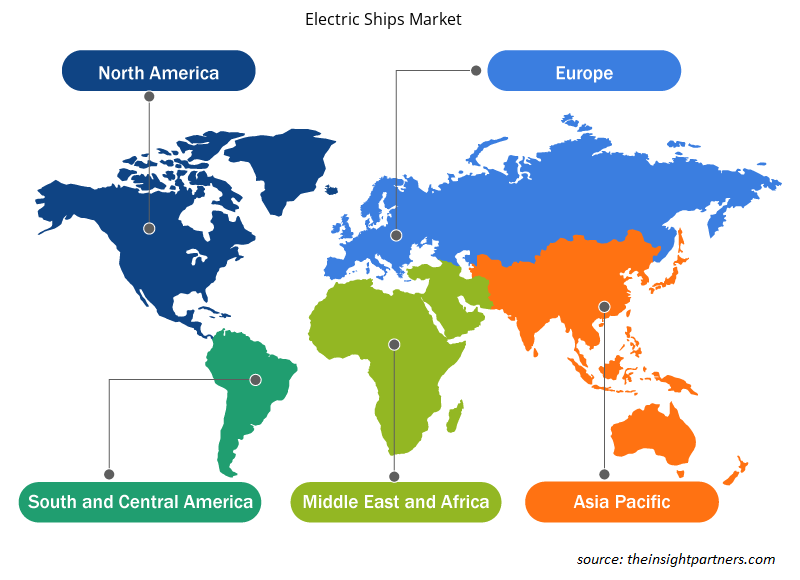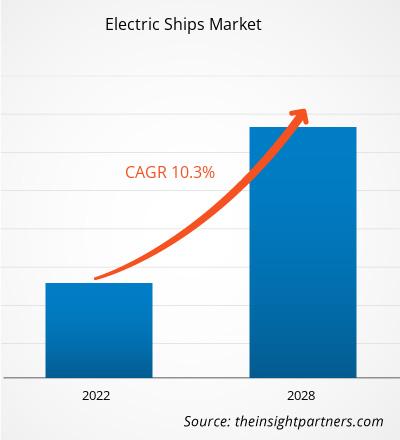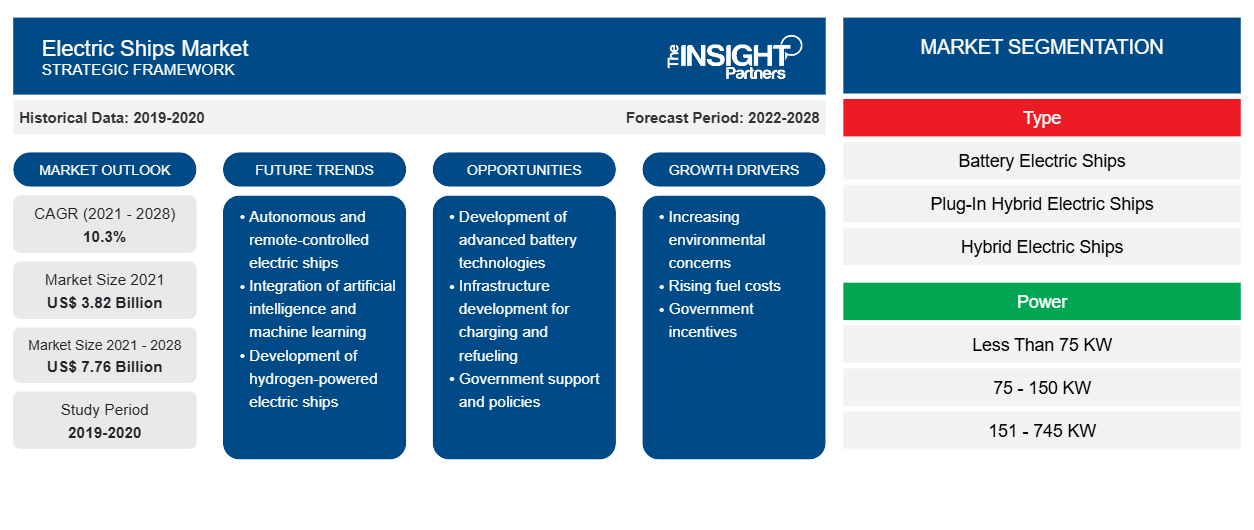بلغت قيمة سوق السفن الكهربائية 3.82 مليار دولار أمريكي في عام 2021، ومن المتوقع أن تنمو بمعدل نمو سنوي مركب نسبته 10.3٪ من عام 2021 إلى عام 2028.
القارب الكهربائي هو أي قارب أو سفينة تعتمد تكنولوجيا الدفع الأساسية فيها على نظام دفع كهربائي. يمكن أن يكون قاربًا أو سفينة كهربائية تعمل بالبطارية بالكامل أو خلية وقود هيدروجينية أو قاربًا أو سفينة هجينة كهربائية، من القاطرات والعبارات وسفن الشحن والقوارب السياحية وسفن الصيد واليخوت السياحية والمركبات تحت الماء بدون طيار (UUVs). يتم تشغيل السفن الكهربائية كهربائيًا، على عكس السفن التقليدية التي تعمل بمحركات الديزل. تستخدم هذه السفن جهاز تخزين البطارية كمصدر للطاقة لتشغيل المحركات الكهربائية. يمكن استخدام أنواع عديدة من البطاريات في السفينة الكهربائية، بما في ذلك بطاريات الليثيوم أيون وبطاريات الرصاص الحمضية وخلايا الوقود. السفن الكهربائية هي في الأساس عبارات وسفن ركاب صغيرة على الممرات المائية الداخلية تبحر بالكامل بالكهرباء. إنها تسافر مسافات قصيرة فقط بحوالي 80 كم في شحنة واحدة. علاوة على ذلك، تُستخدم السفن التي تعمل بالطاقة الشمسية أيضًا في السفن الخفيفة الوزن التي تتطلب خرج طاقة منخفض. ومع ذلك، لا يمكن تلبية متطلبات الطاقة لسفن الشحن بواسطة نظام كهربائي بالكامل بسبب الوزن الثقيل؛ وبالتالي تستخدم سفن الشحن نظامًا هجينًا يعمل بالديزل والكهرباء.
قم بتخصيص هذا التقرير ليناسب متطلباتك
ستحصل على تخصيص لأي تقرير - مجانًا - بما في ذلك أجزاء من هذا التقرير، أو تحليل على مستوى الدولة، وحزمة بيانات Excel، بالإضافة إلى الاستفادة من العروض والخصومات الرائعة للشركات الناشئة والجامعات
- احصل على أهم اتجاهات السوق الرئيسية لهذا التقرير.ستتضمن هذه العينة المجانية تحليلاً للبيانات، بدءًا من اتجاهات السوق وحتى التقديرات والتوقعات.
تأثير جائحة كوفيد-19 على سوق السفن الكهربائية
أثرت جائحة كوفيد-19 سلبًا على سوق السفن الكهربائية . وقد أدت الجائحة إلى تأثيرات عالمية غير مسبوقة على الحركة البشرية. في المحيط، تتأثر الأنشطة القائمة على السفن بسبب القيود الشديدة على الحركة البشرية والتغيرات في استهلاك السلع. أغلقت بعض البلدان صناعة الرحلات البحرية بسبب جائحة كوفيد-19. ومع ذلك، تحاول بعض خطوط الرحلات البحرية استئناف أنشطتها أثناء الوباء. لقد تغيرت الأنشطة البشرية في المحيط بشكل جذري بسبب جائحة كوفيد-19، مع ورود تقارير عن قيود الموانئ وتحولات في أنماط الاستهلاك التي أثرت على قطاعات بحرية متعددة ومصايد الأسماك وعبارات الركاب وسفن الرحلات البحرية. ومع ذلك، في بعض المناطق، تم إعلان شحن البضائع ضروريًا أثناء الإغلاق، مما خلق فرصة مربحة لسوق السفن الكهربائية.
رؤى حول سوق السفن الكهربائية
ارتفاع في استخدام أنظمة الدفع الهجينة والكهربائية لتحديث السفن
تكتسب عملية تجديد السفن اهتمامًا متزايدًا وتجذب مالكي السفن/بناة السفن لتمديد عمر سفنهم الحالية. توفر هذه العملية فرصة لتقليل استهلاك الوقود والبقاء على اطلاع بأحدث الحلول الصديقة للبيئة كإجراء فعال من حيث التكلفة. أصبحت عملية التجديد ممارسة شائعة في صناعة النقل البحري. يتجه بناة السفن نحو الأتمتة، ودمج السفن المبنية حديثًا، وتحديث السفن الحالية بأنظمة الدفع الهجينة والكهربائية. يعد هذا النظام خيارًا مناسبًا لتحديث السفن القديمة ذات إمكانات التحديث الهائلة، بما في ذلك العبارات وسفن الحاويات وسفن الرحلات البحرية والقوارب القاطرة وسفن الشحن العام. يختار بناة السفن تجديد السفن بنظام دفع هجين كهربائي أو نظام دفع كهربائي بالكامل لأنه خيار أرخص نسبيًا من شراء سفينة جديدة. علاوة على ذلك، تعمل العديد من شركات بناء السفن الأوروبية بنشاط على تجديد أسطول سفنها الحالي بأنظمة دفع هجينة وكهربائية. على سبيل المثال، وفقًا للمقال الذي نشرته شركة Riviera Maritime Media Ltd في مارس 2020، استثمر مالكو سفن الإمداد البحرية في تحديث أساطيل تعمل بالديزل والكهرباء/الغاز الطبيعي المسال بنظام دفع هجين يعمل بالبطارية في خطوة تؤتي ثمارها للمستأجر والمالك والقضايا البيئية في النرويج. وقد أدت هذه العوامل إلى اعتماد أنظمة الدفع الهجينة والكهربائية لتحديث السفن.
رؤى السوق القائمة على النوع
بناءً على النوع، يتم تقسيم سوق السفن الكهربائية إلى سفن كهربائية تعمل بالبطارية، وسفن كهربائية هجينة قابلة للشحن، وسفن كهربائية هجينة. قاد قطاع السفن الكهربائية الهجينة السوق في عام 2020. تدعم الموثوقية التي توفرها السفن الكهربائية الهجينة الطلب عليها نظرًا لاستخدام أنظمة الدفع التكميلية والسرعة العالية، مما يمكن أن يقلل من خطر الفشل ويغطي مسافات أكبر في وقت أقل. إلى جانب ذلك، يمكن دفع السفن الكهربائية الهجينة بطريقتين - كهربائية (عبر الديزل الكهربائي أو طاقة البطارية) أو ميكانيكية (مدفوعة بالديزل مباشرة). علاوة على ذلك، يفضل أصحاب السفن أو شركات الشحن والخدمات اللوجستية في جميع أنحاء العالم السفن الكهربائية الهجينة لأنها تمكن من استهلاك أقل للوقود وتساعد في تقليل تكاليف التشغيل. إن استخدام الدفع بالديزل والكهرباء بقوة منخفضة والدفع المباشر بالديزل في حاجة إلى طاقة عالية وهي الإبحار في المياه الداخلية مع ظروف سرعة مختلفة يتيح تقليل التكلفة التشغيلية في السفينة الكهربائية. هذه طريقة أكثر ذكاءً لاستخدام الطاقة المتاحة وتوفير تكاليف الوقود باستخدام الدفع الهجين للسفن الكهربائية.
يتبنى اللاعبون العاملون في سوق السفن الكهربائية استراتيجيات، مثل عمليات الدمج والاستحواذ ومبادرات السوق، للحفاظ على مواقعهم في السوق. وفيما يلي قائمة ببعض التطورات التي قام بها اللاعبون الرئيسيون.
- في نوفمبر 2021، أطلقت شركة BAE Systems نظامًا جديدًا للطاقة والدفع لمساعدة مشغلي السفن البحرية على الوصول إلى انبعاثات صفرية. يوفر هذا النظام حلاً مرنًا يعمل على تحسين الكفاءة الكهربائية ونطاق السفينة، وزيادة قوة الدفع، وتبسيط التركيب.
- في سبتمبر 2020، وقعت شركة كولومبوس (شركة متخصصة في مجال التنقل) وشركة فيلستراند (شركة متخصصة في بناء السفن) عقدًا لتسليم أول عبارة سريعة تعمل بالكهرباء بالكامل في العالم. وقد حصل هذا المشروع على تمويل من برنامج البحث والابتكار أفق 2020 التابع للاتحاد الأوروبي.
بناءً على النوع، يتم تقسيم سوق السفن الكهربائية إلى سفن كهربائية تعمل بالبطارية وسفن كهربائية هجينة قابلة للشحن وسفن كهربائية هجينة. بناءً على الطاقة، يتم تقسيم سوق السفن الكهربائية إلى أقل من 75 كيلو واط، و75-150 كيلو واط، و151-745 كيلو واط، و746-7560 كيلو واط، وأكثر من 7560 كيلو واط. بناءً على المدى، يتم تصنيف سوق السفن الكهربائية إلى أقل من 50 كم، و50-100 كم، و101-1000 كم، وأكثر من 1000 كم. بناءً على نوع السفن، يتم تقسيم سوق السفن الكهربائية إلى سفن سياحية وعبارات وناقلات وناقلات بضائع عامة وسفن صيد ومدمرات وحاملات طائرات وغيرها. من حيث الجغرافيا، يتم تقسيم سوق السفن الكهربائية إلى خمس مناطق رئيسية - أمريكا الشمالية وأوروبا وآسيا والمحيط الهادئ (APAC) والشرق الأوسط وأفريقيا (MEA) وأمريكا الجنوبية (SAM).
رؤى إقليمية حول سوق السفن الكهربائية
لقد قام المحللون في Insight Partners بشرح الاتجاهات والعوامل الإقليمية المؤثرة على سوق السفن الكهربائية طوال فترة التوقعات بشكل شامل. يناقش هذا القسم أيضًا قطاعات سوق السفن الكهربائية والجغرافيا في جميع أنحاء أمريكا الشمالية وأوروبا ومنطقة آسيا والمحيط الهادئ والشرق الأوسط وأفريقيا وأمريكا الجنوبية والوسطى.

- احصل على البيانات الإقليمية المحددة لسوق السفن الكهربائية
نطاق تقرير سوق السفن الكهربائية
| سمة التقرير | تفاصيل |
|---|---|
| حجم السوق في عام 2021 | 3.82 مليار دولار أمريكي |
| حجم السوق بحلول عام 2028 | 7.76 مليار دولار أمريكي |
| معدل النمو السنوي المركب العالمي (2021 - 2028) | 10.3% |
| البيانات التاريخية | 2019-2020 |
| فترة التنبؤ | 2022-2028 |
| القطاعات المغطاة | حسب النوع
|
| المناطق والدول المغطاة | أمريكا الشمالية
|
| قادة السوق وملفات تعريف الشركات الرئيسية |
|
كثافة اللاعبين في سوق السفن الكهربائية: فهم تأثيرها على ديناميكيات الأعمال
يشهد سوق السفن الكهربائية نموًا سريعًا، مدفوعًا بالطلب المتزايد من المستخدم النهائي بسبب عوامل مثل تفضيلات المستهلكين المتطورة والتقدم التكنولوجي والوعي المتزايد بفوائد المنتج. ومع ارتفاع الطلب، تعمل الشركات على توسيع عروضها والابتكار لتلبية احتياجات المستهلكين والاستفادة من الاتجاهات الناشئة، مما يؤدي إلى زيادة نمو السوق.
تشير كثافة اللاعبين في السوق إلى توزيع الشركات أو المؤسسات العاملة في سوق أو صناعة معينة. وهي تشير إلى عدد المنافسين (اللاعبين في السوق) الموجودين في مساحة سوق معينة نسبة إلى حجمها أو قيمتها السوقية الإجمالية.
الشركات الرئيسية العاملة في سوق السفن الكهربائية هي:
- بي ايه اي سيستمز
- شركة دافي للقوارب الكهربائية
- شركة فيلستراند
- الشاطئ اكس
- قارب كهربائي من جنرال ديناميك
إخلاء المسؤولية : الشركات المذكورة أعلاه ليست مرتبة بأي ترتيب معين.

- احصل على نظرة عامة على أهم اللاعبين الرئيسيين في سوق السفن الكهربائية
نبذة عن الشركة
- بي ايه اي سيستمز
- شركة دافي للقوارب الكهربائية
- شركة فيلستراند
- الشاطئ اكس
- قارب كهربائي من جنرال ديناميك
- هورتيجروتين
- شركة مان لحلول الطاقة
- بورتلاينر
- شركة سيمنز للطاقة
- فارد أس
- التحليل التاريخي (سنتان)، سنة الأساس، التوقعات (7 سنوات) مع معدل النمو السنوي المركب
- تحليل PEST و SWOT
- حجم السوق والقيمة / الحجم - عالمي، إقليمي، بلد
- الصناعة والمنافسة
- مجموعة بيانات إكسل
التقارير الحديثة
شهادات العملاء
سبب الشراء
- اتخاذ قرارات مدروسة
- فهم ديناميكيات السوق
- تحليل المنافسة
- رؤى العملاء
- توقعات السوق
- تخفيف المخاطر
- التخطيط الاستراتيجي
- مبررات الاستثمار
- تحديد الأسواق الناشئة
- تحسين استراتيجيات التسويق
- تعزيز الكفاءة التشغيلية
- مواكبة التوجهات التنظيمية





















 احصل على عينة مجانية ل - سوق السفن الكهربائية
احصل على عينة مجانية ل - سوق السفن الكهربائية